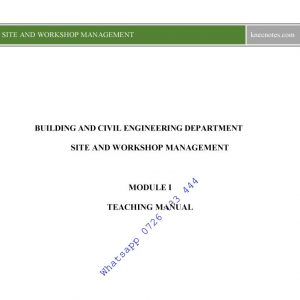Description
1.0 CHAPTER ONE: FORCES
- 1.1 INTRODUCTION
- 1.1.1 Effects of a force
- 1.1.2 Scalar and Vector Quantities
- 1.2 FORCE VECTORS
- 1.2.1 Force Systems
- Concurrent forces
- Collinear forces
- Coplanar forces
- 1.2.2 Vector Addition
- 1.3 RESULTATION AND RESOLUTION OF FORCES
- 1.3.1 Resolution into Perpendicular Components
- 1.3.2 The Resultant of Two Coplanar Forces
- 1.3.3 Analysis/Calculation Method of Resultation
- 1.4 STATEMENT AND APPLICATION OF THEOREMS OF FORCES
- 1.4.1 Parallelogram Theorem
- The Parallelogram of Forces Method
- 1.4.2 Triangle Theorem
- Triangle of Forces Method
- 1.4.3 Polygon Theorem
- Polygon of Forces Method
- 1.4.4 Coplanar Forces in Equilibrium
- Bow’s Notation
- 1.4.5 Lami’s Theorem
- 1.4.6 Equilibrant
- 1.5 SUMMARY
- EXTENDED ANSWER/KNEC SAMPLE QUESTIONS
2.0 CHAPTER TWO: MOMENTS OF FORCES
- 2.1. INTRODUCTION 2.1.1 Directions of Moments
- 2.1.2 Principle of Moments
- 2.2 EQUILIBRIUM AND CENTRE OF GRAVITY (CoG)
- 2.2.1 Stable Equilibrium
- 2.2.2 Unstable Equilibrium
- 2.2.3 Neutral Equilibrium
- 2.2.4 Factors Affecting Stability
- Area of Base
- Position of CoG
- 2.3 CALCULATION OF MOMENTS
- 2.4 CALCULATION OF REACTIONS
- 2.4.1 Single Load on Beam
- 2.4.2 Multiple Loads on Beams
- 2.4.3 Making Reactions at the Supports to be Equal
- Changing Position of Load
- Changing Magnitude of Load
- 2.5 VARIGNON’S THEOREM
- 2.6 COUPLES
- 2.6.1 Applications of Couples
- EXTENDED ANSWER/KNEC SAMPLE QUESTIONS
3.0 CHAPTER THREE: FRICTION
- 3.1 TYPES OF FRICTION
- 3.1.1 Dry Friction.
- 3.1.2 Fluid Friction
- 3.1.3 Internal Friction.
- 3.2 COEFFICIENT OF FRICTION
- 3.3 LAWS OF FRICTION
- 3.4 ANGLE OF FRICTION AND ANGLE OF REPOSE
- 3.4.1 Angle of Friction
- 3.4.2 Angle of Repose
- 3.4.3 Motion up a plane with the pulling P force parallel to the plane
- 3.4.4 Motion down a plane with the pulling force P parallel to the plane
- 3.4.5 Motion up a plane due to a horizontal force P
- 3.5 APPLICATIONS OF FRICTION
- 3.6 ADVANTAGES OF FRICTION
- 3.7 DISADVANTAGES OF FRICTION
- 3.8 INCREASING AND REDUCING FRICTION
- Increasing
- Reducing
- 3.8 SUMMARY
- EXTENDED ANSWER/KNEC SAMPLE QUESTIONS
4.0 CHAPTER FOUR: MOTION
- 4.1 INTRODUCTION/DEFINITIONS
- 4.1.1 Simple Calculations
- 4.2 NEWTON’S LAWS OF MOTION
- 4.2.1 Newton’s First Law of Motion (Law of Inertia)
- 4.2.2 Newton’s Second Law of Motion (Law of Momentum)
- 4.2.3 Newton’s Third Law of Motion (Action-Reaction Law)
- 4.3 GRAPHS OF MOTIONS
- 4.3.1 Displacement-Time Graph
- 4.3.2 Velocity-Time Graph
- 4.3.3 Acceleration-Time Graph
- 4.4 EQUATIONS OF MOTION
- 4.4.1 Linear Motion
- First equation
- Second equation
- Third equation
- Fourth equation
- 4.4.2 Motion under Gravity
- Free Fall
- Vertical projection
- Time of flight
- Maximum height reached
- Velocity to return to point of projection
- 4.4.3 Horizontal projection
- 4.4.4 Angular Motion (Uniform Circular Motion)
- The radian
- Angular velocity
- Angular acceleration
- Centripetal force
- Motion of Bicycle Rider Round Circular Track
- Motion of Car (or Train) Round Circular Track
- Motion in a vertical circle
- EXTENDED ANSWER/KNEC SAMPLE QUESTIONS
5.0 CHAPTER FIVE: ENERGY, WORK AND POWER
- 5.1 ENERGY
- 5.1.1 Potential Energy/Energy at Rest
- 5.1.2 Kinetic Energy/Energy of Motion
- 5.1.3 Conservation of Energy
- 5.1.4 Linear Momentum
- 5.1.5 Conservation of Linear Momentum
- 5.1.6 Elastic and inelastic collisions
- 5.2 WORK
- 5.2.1 Calculating Work
- 5.3 POWER
- EXTENDED ANSWER/KNEC SAMPLE QUESTIONS
(Visited 1,373 times, 1 visits today)






Reviews
There are no reviews yet.